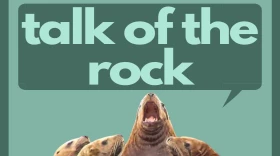The Alaska Food Policy Council held its statewide food festival and conference in Kodiak this year – marking the first time the event has ever been hosted in a community off the road system.
Dehrich Chya [Isuwiq] of the Alutiiq Museum kicked things off on Friday, March 28 with the lighting of a traditional seal oil lamp. Historically he said lamps or naniq like these were used for warmth, light and to encourage the sharing of Alutiiq culture.
“People would gather around oil lamps to do arts and crafts, and perpetuate Alutiiq/Sugpiag culture by making stuff, just having conversations and dancing," Chya said. "And so today we light lamps not for the light and warmth necessarily, but to honor that tradition and this idea of perpetuating our culture.”

The two-day conference organized by the Alaska Food Policy Council happens every year and a half and focuses on food security, with presentations about subsistence, mariculture and developing local agriculture around the state. It also featured pre-conference events on Thursday, March 27, like a film screening of "Nourishing the Kenai" and panel discussion with members of the Kenaitze Indian Tribe of Kenai.
Robbie Townsend Vennel is the executive director of the Kodiak Archipelago Leadership Institute, which oversees a network of farms across the island called Alutiiq Grown. This network consists of soil, hydroponic and kelp farms. She said the idea for the farm collaborative started a decade ago and now includes food programs in five villages and the city of Kodiak.
“Now we are taking the Alutiiq Grown model to the Chugach region, Alutiiq region, to assist in establishing hydroponic production in their villages," Vennel said. "So Alutiiq Grown is now going to be Alutiiq region-wide.”
Vennel was one of several people to give opening remarks at the food conference hosted in the Kodiak Marketplace. After hearing pre-recorded speeches from each of Alaska’s three congressional delegation members, the conference broke out into a multitude of sessions spread between three rooms upstairs in the Marketplace and the harbor room at the Best Western.

The director of the Alaska Division of Agriculture, Bryan Scoresby, focused his speech on the need to improve food security across the state. He noted how Alaska imports roughly 95% of its food from outside the state, and the same is true of Kodiak Island.
Meghan Hargis, with the Alaska Food Policy Council, said since the COVID-19 pandemic, she has seen an emphasis on producing more local food from a variety of sources statewide. She spoke to KMXT during its public affairs show Talk of the Rock on March 18, ahead of the statewide food conference in Kodiak.
“Locals realized just how dependent we are on these systems that are very fragile and when trucks aren’t coming through Canada or the barge isn’t running up from Seattle, we’re very food insecure," Hargis explained.
Hargis points out that Alaska is one of only two states in the country without a Department of Agriculture. She said there seemed to be a lot of support to create the department and approve Governor Mike Dunleavy’s executive order in the Legislature, but state lawmakers narrowly rejected it on March 19, arguing that the order as written did not support food security according to Alaska Public Media.

Locally in the Kodiak archipelago, there are a handful of micro-scale hydroponics and soil farms, a goat dairy and several mariculture operations. Dried kelp, kelp popcorn and a handful of those Kodiak grown products were highlighted during the homemade food fair on the final day of the conference.
Dune Lankard, the final of three keynote speakers, gave his presentation that same day on March 29 while attendees ate lunch from local caterer Nuniaq. Lankard is the president and founder of Native Conservancy, which focuses on protecting habitat and preserving Alaska Native culture along with food sovereignty. He said his organization is helping Indigenous communities use kelp and mariculture for three main reasons.
“One, so they could help heal and restore the ocean. Number two, to feed their people a traditional food source that they’ve enjoyed for thousands of years," he said. "And three, to build a regenerative economy that they could be part of and proud of.”
Lankard said having a regenerative economy could be key for keeping more people in their home communities off the road system, including in the Kodiak archipelago.




